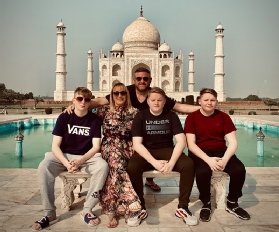
Fotolia
Benelux CIO interview: Richard Ventre, SHV Holdings
In his role at Netherlands-based SHV Holdings, Richard Ventre is tackling the challenge of enabling a diverse set of digital transformations across a range of industries
The diversity of Dutch multinational SHV Holdings attracted Richard Ventre to its group CIO role and presented him with the challenge of supporting different business strategies and digital transformation needs.
SHV Group operates in a diverse range of industries, with six operating companies, including retail brand Macro along with heavy lifting, engineering, animal feed, financial services and energy businesses.
Ventre joined the 126-year-old Dutch company in January 2022 after a long period in IT leadership roles in the ports and logistics sector.
Today, he is tasked with creating the foundation to enable each of the group’s businesses to apply industry-specific know-how to autonomously pursue their own digital transformations.
Ventre, originally from Liverpool, gained his first degree in computer science in 1999 at Liverpool John Moores University, before joining IT supplier CSC as part of a graduate programme. He went on to spend 10 years at the company.
During his time at CSC, as well as completing his master’s in computer science, he held various roles, including heading up database capability globally and working on the company’s NHS contract for the north-west cluster.
His final role at CSC was working on its contract with financial services giant Zurich Insurance, based in the Swiss city. When his wife was expecting triplets, the couple decided to head back to the UK, to be near family.
“That made us rethink. At the time, I had been at CSC for 10 years and was the service management director on the Zurich account,” he said.
He was approached by Network Rail to become head of IT operations, an opportunity he seized and spent seven years there.
Working in Zurich gave Ventre a taste for work outside the UK so, after leaving Network Rail, he was back on his travels. He joined Maersk as global IT director for the shipping company’s terminals business, based in The Hague. Ventre says he loved the Netherlands and the people, and the job was going really well, but after three years in the Hague, he received “an offer I couldn’t refuse” from Adani Group conglomerate in India. “They were doing some really interesting stuff,” he says.

Ventre became CIO for the Adani Ports and Logistics business. Working directly for the son of billionaire Gautam Adani, he began leading the digital transformation of the business and the move from “analogue ports into smart ports”, he tells Computer Weekly.
But when the Covid-19 pandemic hit India and his children’s school closed, Ventre and his wife decided to relocate back to Europe. “We got the company working remotely, were delivering things remotely, and achieved quite a lot, but in about June 2021, my wife and I decided the kids couldn’t do the remote schooling any longer, so I put the feelers out for a new role,” he says.
Cross-industry focus at SHV
Six months later, Ventre was offered a job at SHV Holdings and the opportunity to move back to the Netherlands. He joined in January 2022 and now spends the week in Utrecht and weekends with the family in Liverpool.
“The opportunity attracted us because we knew the Netherlands and we liked the place. It also got me out of the ports and shipping sector, which is a good sector, but I didn’t want to become pigeon-holed,” says Ventre. “As the group CIO, [I work] across several industries, which was a big attraction for me.”
At SHV, Ventre has seven people reporting directly to him. These include heads of architecture, information risk and security, and the head of digital data, who all have their own teams.
The businesses within SHV Holdings also have their own IT teams. “We are a holding company and each business within SHV is completely independent with its own CIO and management board,” says Ventre.
The diversity of the businesses in the group means there is no one-size-fits-all digital transformation approach. “This is a really key point,” according to Ventre.
A diverse set of businesses has diverse digital transformation strategies. “Each business has its own digital strategy, and as a CIO at a group level that can be difficult. I am working with seven very different business strategies,” said Ventre.
To address this, the group has established a strategy, known as Better Together. “Whilst we are very different in terms of our operating models, businesses and industries, we have got a lot of commonalities in what we do around the classic commodity IT like networks, servers, service desk and application support,” he says.
“The Better Together strategy is looking at consolidating the supply chain for global partners who can introduce standards across commoditised IT. That created the platform to allow CIOs to focus on digital transformation of the business,” adds Ventre. “It will be low-cost, repeatable and based on standards, allowing CIOs across the group to focus on what’s important.”
He says he can’t drive digital transformation at group level, but can support the CIOs in their endeavours. His strategy is to reduce the cost of commodity IT, set architecture principles and guidelines, and allow CIOs the freedom to execute their digital transformation.
“We try not to get too involved in part three beyond governance. We respect the decentralised nature of our business, and the CIOs need autonomy, but there are some things that are non-negotiable, such as commodity IT and governance around certain digital transformations if a certain size,” says Ventre.
Digital transformation in train
Digital transformation across the group is well underway. For example, SHV’s testing, inspection and certification business, Kiwa, is using digital technology to improve business operations.
“A lot of that can now be done remotely using internet of things (IoT) technology. Component parts are hooked up to the internet and sending messages to enable predictive maintenance,” says Ventre. “Predictive maintenance is already being done, but eventually there will be remote certification and no need for the engineer to go onsite to check maintenance.”
SHV’s Eriks business, which manufactures equipment, is also using IoT technology to offer digital services. With customers such as large beer manufacturers, Eriks would traditionally sell parts and equipment, but it now sells services on top. “The product now comes with software that allows the user to understand the product’s health through IoT technology.”
Ventre adds that maintenance teams at Eriks are also using virtual reality for training and support during maintenance.
Meanwhile, in its Mammoet cranes business, the use of digital technology is improving projects. “A lot of time is wasted debating whether a job can continue during high winds,” says Ventre. "In the future sensors can determine the wind speed and allow for fact based decision making ”
It is also using data to forecast, plan and risk assess jobs, which would have been done less efficiently on spreadsheets in the past.
Read more CIO interviews
-
Steve Capper, CIO of SNC-Lavalin, has consolidated its global datacentre estate and implemented private cloud to support the unique demands of its business.
-
Marc Jennings, CIO of analytics and AI at TUI, is overhauling its data stack and aims to provide self-service analytics to key employees across the organisation.
-
Andy Pocock, IT director at TrustFord, has been through a complete digital transformation that embraces cloud, mobile working and automation.










